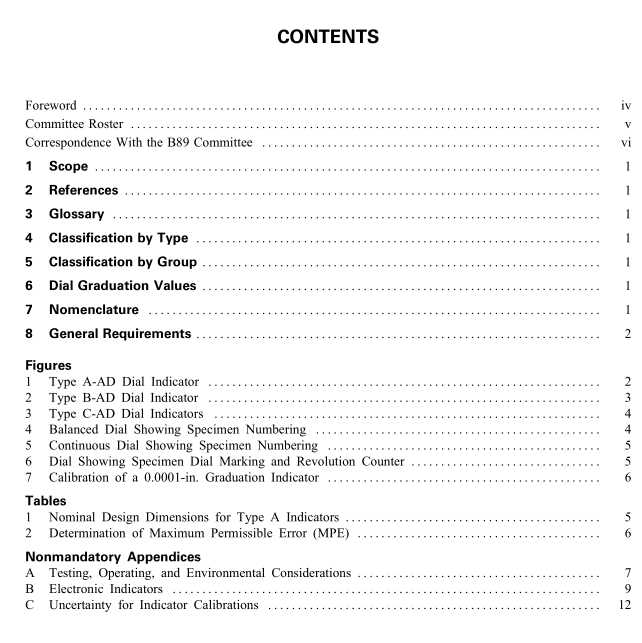ASME B89.1.10M:2001 pdf free download DIAL INDICATORS (FOR LINEAR MEASUREMENTS)
1 sCOPE
This Standard is intended to provide the essentialrequirements for dial indicators as a basis for mutualunderstanding between manufacturers and consumers.Described herein are various types and groups of dialindicators used to measure a linear dimension of avariation from a reference dimension.
2 REFERENCES
CS(E) 119-45 Dial Indicators (For Linear Measurements)Publisher: Department of Commerce,1401 ConstitutionAvenue NW, Washington,DC 20230
A-A-2348B Indicator,Dial,Accessories,and Test SetPublisher: General Services Administration,1800 FStreet Nw,Washington,DC 20405
MIL-I-8422D Indicators,Dial and Accessories
Publisher: National Technical Information Service(NTIS),5285 Port Royal Road,Springfield VA22161
ISO R/463 Dial Gauges Reading in 0.01 mm,0.001in. and 0.0001 in.
Publisher: International Organization for Standardization(ISo),1 rue de Varembe,Case Postale 56,CH-i211,Geneve,Switzerland/Suisse
3 GLOSSARY
dial indicator:a measuring instrument in which smalldisplacements of a spindle or a lever are magnifie bysuitable mechanical means to a pointer rotating in frontof a circular dial having a graduated scale.
error of indication:the amount by which the displayedvalue on a measurement device differs from the trueinput.
4 CLASSIFICATION BY TYPE
(a) Type A. Dial indicators in which the spindle isparallel to the dial face (see Fig. 1).
(b) Type B. Dial indicators in which the spindle is perpendicular to the dial face (see Fig. 2).
(c) Type C. Dial indicators in which the measuringcontact member is a lever.These are also known asdial test indicators (sce Fig. 3).
5 CLASSIFICATION BY GROUP
Group members are assigned in accordance withnominai bezel diameter and apply only to Type A andBindicators (Table 1). For Type C indicators,whichare available in a variety of sizes and designs.refer tothe various manufacturers’ standards. Group descriptionsare as follows:
(a) Group 0. Dial indicators having nominal bezeldiameters from 1 in. (25 mm) up to and including 13/8in. (35 mm).
(b) Group 1. Dial indicators having nominal bezeldiameters from above 13/s in. (35 mm) up to andincluding 2 in. (50 mm).
(c) Group 2. Dial indicators having nominal bezeldiameters from above 2 in. (50 mm) up to and including23/ in. (60 mm).
(d) Group 3. Dial indicators having nominal bezeldiameters from above 23/s in. (60 mm) up to andincluding 3 in. (76 mm).
(e) Group 4.Dial indicators having nominal bezeldiameters from above 3 in. (76 mm) up to and including3/4 in. (95 mm).
6 DIAL GRADUATION VALUES
All types of indicators shall have least graduationsarranged either in four classes of inch values (i.e.,0.00005 in.,0.0001 in.,0.0005 in.,and 0.001 in.) orin four classes of metric values (i.e.,0.001 mm,0.002mm,0.01 mm,and 0.02 mm).
NOTE:Other values for graduations are sometimes used in industry.The supplier and the customer should agree on the determination ofthe maximum permissible error for dial indicators with graduationsnot mentioned in this Standard.
7 NOMENCLATURE
For the purposes of this Standard, the nomenclaturein Figs. 1 through 6 shall apply.
8 GENERAL REQUIREMENTS
8.1 Materials
8.1.1 Bearings. All types ofindicators are furnished with either plain or jeweled bearings, or a combination of both.
8.1.2 Case. Dial indicator cases shall be of such strength and rigidity as to ensure free movement of the mechanism under normal shop condition.
8.1.3 Contact Points. Contact points shall be of hardened steel or other wear-resistant material with smooth uniform gaging surfaces. Except for Type A, Group 0, and Type C dial test indicators, all points shall have a #4–48 thread.
8.1.4 Crystals. The crystals shall be clear and preferably of nonshattering material.
8.2 Construction
8.2.1 Position. The zero position of the dials shall be adjustable over a range of 360 deg and the desired position fxed by a locking device or held by friction means between the case and bezel.
8.2.2 Dial Hands. The width of the tip shall be approximately the same as that of a graduation line on the dial face. Type A, 2 1 ⁄ 2 -revolution indicators, shall have their hands set at approximately the nine o’clock position when the spindle is fully extended. One-revolution indicators shall have their hands set at approximately the six o’clock position at the bottom of the indicator dial. Type B indicators shall have their hands set in accordance with individual manufacturer’s practice. Type C indicators will have their hands set at either the six o’clock or twelve o’clock position with the lever at rest.
ASME B89.1.10M:2001 pdf free download
